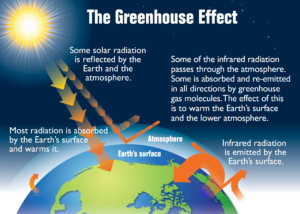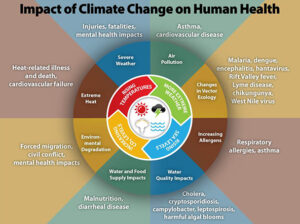So What IS Climate Change?
At a recent nursing meeting that I attended I asked nurses to pair up and role play the following: “Your neighbor has just asked you – so what IS climate change?”. Each nurse had to take a turn with a partner and answer that question, as though she/he were telling her neighbor the answer. After completing the role play, I asked how many of the nurses were able to answer that question with a high level of confidence and only about 10% raised their hands. When I asked how many could answer with reasonable confidence only another 10% raised their hands. How about you, would you feel confident answering the question? What everyone discovered from this activity was how unprepared many nurses are to talk about what climate change is. While nurses are more familiar with what climate change seems to be causing, such as more extreme weather events, sea level rise, and extensive wildfires, a large portion are unable to explain what climate change is in simple terms.
So here is a little primer:

The earth’s temperature has historically been modulated by the sun’s rays beating down, warming the land and water, and then radiating heat back out beyond the earth’s atmosphere. This process has kept the earth at a livable temperature for humans and other lifeforms to flourish. However, we now have a “blanket” of gases that are surrounding the earth, gases created substantially by human activities such as transportation, energy production, industry, cooking/heating, and agriculture. These gases are called greenhouse gases because they create the same warming effect as a greenhouse and are slowly warming the earth – both the land and particularly the oceans. And in the process they are changing our climate. Climate is distinguished from weather in that weather is what occurs from day to day or week to week, but climate is what occurs over longer periods of time, month to month and year to year.
The process is a bit like what happens to your car when you leave it outside in the sun with the windows up. The sun’s rays heat the inside of the car and that heat cannot adequately escape, so the car heats up.
Just as there is a small range of body temperatures at which humans can be healthy, the same is true for all species on earth. When human temperatures rise from 98.6 to 100.4 degrees it means the difference from feeling fine to having a fever and not feeling well. When our temperatures get even higher we begin to see bodily system distress and damage. What happens when the earth has a fever?
As the earth warms, we are beginning to see shifts in climate which are resulting in some areas seeing much more rain and others much less, some colder winters, some hotter summers. As we encounter more extreme heat days and extended heat waves, we are going to see many more heat-related illnesses and even deaths in humans. People who work outside in agriculture, utilities, construction, gas/oil, and many other fields will be at higher risk for hyperthermia. And, of course, extreme storms and wildfires have been taking an enormous toll on human and ecological health

Changes to the earth’s climate can have irreversible effects on plants, including our agricultural food crops. Rising ocean temperatures is affecting plankton which is the foundation of the food chain for fish and sea mammals. An estimated billion people are dependent on fish as their main source of protein. In addition to interrupting the world’s food supply, there are a great many other health threats that are associated with the changes we are seeing. For an extensive list of how climate change affects human health, visit https://bit.ly/2qNLNtW.
While there are some natural sources of greenhouse gases, the ones that we have the most capacity to reduce are those that are manmade. As individuals we can assess our household’s contribution to greenhouse gases by using a “carbon footprint calculator”, such as this one from the U.S. Environmental Protection Agency: https://bit.ly/1XIc9pa. As nurses, we can help promote climate healthy purchasing and practices in our health care facilities, K – 12 schools, faith-based organizations, universities, and any other settings in which we have influence.
The new International Council of Nurses (which ANA is a member of) announced its new position statement on climate change in September 2018 and calls on all nurses to help address climate change (see: Nurses, climate change and health). It calls for us to heed the scientific evidence which, in the case of climate change, is abundant.
We must be able to talk about this issue with a degree of confidence and we must engage both individually and as a profession to advocate for policies and practices that will decrease greenhouse gas production from a wide range of its sources. The truth is climate change is a health issue and that’s what we nurses are all about.
For more resources on climate change and health, including nurse-focused guides and webinars, visit the Alliance of Nurses for Healthy Environments’ Climate and Health Toolkit: climateandhealthtoolkit.org. To join our free monthly calls on climate change and nursing please email the authors.




